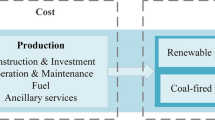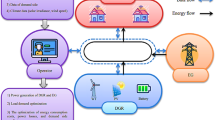Abstract
This paper investigates the incentives market participants have in the German electricity balancing mechanism. Strategic over and undersupply positions are the result of existing stochastic arbitrage opportunities between the spot market and the balancing mechanism. Clear indications for strategic behavior can be observed in aggregate market data. These structural imbalances increase the need for reserve capacity, raise system security concerns, and therefore place significant costs on consumers. The underlying problem is the disconnect between spot market, reserve capacity market and balancing mechanism. Alternative market design options discussed in this paper suggest better alignment between these markets/mechanisms.










Similar content being viewed by others
Notes
Each of the four German TSOs administrates a control zone for which schedules have to be submitted separately. The schedules have to balance on paper and do not account for transmission constraints. This does not only ensure that the system is overall in balance from a planning perspective, but also helps the TSOs to estimate where and when physical constraints are to be expected.
Reserve energy and balancing energy are identical. Both refer to the energy required to balance the system. It is called reserve energy when looking from the perspective of provision as it is provided by reserve capacity, and balancing energy from the usage perspective as it is used for balancing.
For primary reserve only a reservation price applies. The actual use is not rewarded separately as it is assumed that incremental and decremental primary reserve energy offset each other. Therefore, primary reserve is not relevant for the purpose of this paper and is not considered further.
The costs for reserving capacity are passed on to the consumers of electricity via grid fees. Therefore, reservation prices are of little relevance for the following discussion and the focus is on reserve energy prices.
The auctions were held half-yearly before December 2007. Weekly auctions were introduced in June 2011.
The balancing price (€/MWh) is determined as the sum of all cost for utilized secondary and tertiary reserve energy divided by the average imbalance during the 1/4-h.
For completeness and as it becomes relevant later in the paper, balancing groups have the possibility to adjust their submitted schedules retroactively until 4 p.m. day-after. Energy and therefore imbalances can be traded retroactively on paper between two balancing groups to change their submitted load schedules. However, given the balancing mechanism is a one-price system, there are no win-win situations. Only reducing the uncertainty, until balancing prices are known 2 months later, provides an incentive why market participants should exchange their imbalances. The day-after market exists, but is largely irrelevant in practice.
The magnitude of the discontinuity between decremental and incremental prices is a result of the secondary reserve auction design, technical properties of the plants providing reserve and presumably bidding behavior in a not fully competitive market. A detailed analysis of the discontinuity is beyond the scope of this paper.
The normal distribution is often used to describe load forecast errors (see Brueckl 2006; Hodge et al. 2013). Load forecasts of individual balancing groups are not public and empirical evidence of the distribution of forecast errors is scarce. Consentec (2008) analyzed load forecasts of balancing groups and concluded that load forecast errors reasonably resemble a normal distribution with a 2 % standard deviation. More often load forecast errors are analyzed at a control zone level using imbalance data. Hufendiek (2001) found evidence that day-ahead load forecast errors for the German control zones are more leptokurtic than a normal distribution and have fatter tails. Hodge et al. (2013) derived similar results in the US context. When analyzing deviations between planned and actual load schedules at the control zone level, the load forecast error is already overlaid with other effects. As load forecast errors of individual balancing groups are likely to be correlated due to the weather influence, the accumulated load forecast errors of all balancing groups in the control zone are expected to be more leptokurtic and have fatter tails. Furthermore, any deliberate deviation of a balancing group from its forecast as analyzed in this paper also lead to fatter tails and deviations from a normal distribution.
This simplifying assumption reflects the high liquidity of the German spot market. The impact of the over/ undersupply on the expected spot price is rather small and only a secondary effect in this analysis. For simplicity reasons it is assumed that this secondary effect is already internalized in the expected spot price. The effect on the spot price is discussed and quantified in Sect. 7.
Given the properties of the probability density and cumulative distribution function, the RHS of Eq. (8) is strictly monotonically increasing within the co-domain ]0;1[, which is exactly the co-domain of the LHS for \(E(P^{Dec})<E(P^{Spot})<E(P^{Inc})\). Hence, the obtained numerical solution is unique.
The day-ahead spot prices are a more robust price signal as the day-ahead market is significantly more liquid. Therefore, the following analysis is conducted both with day-ahead and intraday spot prices (see Appendix). The results are structurally identical with only minor deviations.
Moeller et al. (2011) also show that market participants took these strategic positions in the German balancing system during the years 2003–2008.
So far there have been no signs that the contracted reserves are insufficient. The German TSOs carry out an annual analysis to determine the reserve requirements, which implicitly takes into account the structural imbalances caused by strategic behavior. If the future strategic behavior increases, the reserves might prove insufficient and critical system conditions could arise (as happened in February 2012).
During the period May 2009–April 2010, the German TSOs procured \(\sim \)2700 MW incremental secondary reserve capacity for an average of 10.3 €/MW per h, \(\sim \)2200 MW decremental secondary reserve capacity for 10.7 €/MWh, \(\sim \)2500 MW incremental tertiary reserve capacity for 1.9 €/MWh, and \(\sim \)2600 MW decremental tertiary reserve for 6.2 €/MWh (calculation based on auction data from Regelleistung 2012).
Such a balancing mechanism would be a two-price system as different prices are applied for over and undersupplied balancing groups. Currently, a one-price system is applied in Germany with the same balancing price for positive and negative imbalances (cf. Vandezande et al. 2010).
Reducing the contract durations for secondary reserve leads to more efficient market results as shown by Just (2011). The resulting improved generation dispatch yields lower prices in the reserve capacity market as well as in the spot markets. Furthermore, shorter contract durations would lower the barriers to entry for smaller companies and thus lead to more competitive market results.
References
50Hertz. (2012). Balancing price and imbalance data. http://www.50hertz-transmission.net.
Amprion. (2012a). Balancing price and imbalance data. http://www.amprion.net.
Amprion. (2012b). Information about balancing group contracts on the company webpage. http://www.amprion.net/en/balancing-group-management.
BMWi. (2012). German energy data-data collection by the German Federal Ministry for Economic Affairs and Energy. http://www.bmwi.de.
BNetzA. (2010). Ruling on grid control cooperation for German grid. B6–08-111 (in German) by the German Regulatory Authority. http://www.bundesnetzagentur.de.
BNetzA. (2012a). Report on energy supplies in winter 2011/2012 (in German), by the German Regulatory Authority. http://www.bundesnetzagentur.de.
BNetzA. (2012b). Ruling on enhancements in the German balancing mechanism. B6–12-024 (in German) by the German Regulatory Authority. http://www.bundesnetzagentur.de.
Boogert, A., & Dupont, D. (2005). On the effectiveness of the anti-gaming policy between the day-ahead and the real-time electricity market in The Netherlands. Energy Economics, 27, 752–770.
Brueckl, O. (2006). Probabilistic determination of the reserve capacity requirements in the electricity system (in German). Ph.D. dissertation, Technical University of Munich.
Bushnell, J. B., & Oren, S. S. (1994). Bidder cost revelation in electric power auctions. Journal of Regulatory Economics, 6, 5–26.
Chao, H., & Wilson, R. (2002). Multi-dimensional procurement auctions for power reserves: Robust incentive-compatible scoring and settlement rules. Journal of Regulatory Economics, 22, 161–183.
Consentec. (2008). Expert opinion of the required amount of system reserve capacity. Report for the German Federal Regulatory Autherity. http://www.bundesnetzagentur.de.
EEX. (2012). Market data on day-ahead and intraday spot prices. http://www.eex.de.
ELCON. (2004). The economic impacts of the August 2003 blackout. Electric consumer research council. http://www.elcon.org/Documents/EconomicImpactsOfAugust2003Blackout.pdf.
Energate. (2012). Suspicion: Traders have compromised the electricity grid (in German). Energate Netze monthly report.
ERGEG. (2006). Guidelines of good practice for electricity balancing markets integration by the European Regulators group for electricity and gas. Accessed December 06, 2006, from http://www.energy-regulators.eu.
FAZ. (2012). Escaping barely the collapse (in German). Frankfurter Allgemeine Zeitung. Accessed February 16, 2012, from www.faz.net/aktuell/wirtschaft/stromversorgung-dem-kollaps-knapp-entgangen-11651935.html.
Growitsch, C., Weber, C. (2008). On the electricity reserves market redesign in Germany. CNI-Working Paper, Technical University Berlin.
Hodge, B.-M., Lew, D., Milligan, M. (2013). Short-term Load forecasting error distributions and implications for renewable integration studies. In Proceedings of IEEE green technologies conference, Denver.
Hufendiek, K. (2001). Systematic Development of Load Forecasting Systems based on Neural Networks (in German). Ph.D. dissertation, University of Stuttgart.
Just, S. (2011). Appropriate contract durations in the German markets for on-line reserve capacity. Journal of Regulatory Economics, 39, 194–220.
Just, S., & Weber, C. (2008). Pricing of reserves: Valuing system reserve capacity against spot prices in electricity markets. Energy Economics, 30, 3198–3221.
Moeller, C., Rachev, S. T., & Fabozzi, F. J. (2011). Balancing energy strategies in electricity portfolio management. Energy Economics, 33, 2–11.
Rammerstorfer, M., & Müller, G. (2008). A theoretical analysis of procurement auctions for minutes reserve control in Germany. Energy Policy, 36(7), 2620–2627.
Rammerstorfer, M., & Wagner, C. (2009). Reforming minute reserve policy in Germany: A step towards efficient markets? Energy Policy, 37(9), 3513–3519.
Regelleistung (2012). Results from reserve capacity auctions of the German TSOs. http://www.regelleistung.net.
Schummer, J., & Vohra, R. V. (2003). Auctions for procuring options. Operations Research, 51, 41–51.
Stoft, S. (2002). Power system economics—Designing markets of electricity. Piscataway, NJ: Wiley Press.
Swider, D. J. (2007a). Competition in the German market for power systems reserve? (in German). Energiewirtschaftliche Tagesfragen, 57(9), 32–37.
Swider, D. J. (2007b). Efficient scoring-rule in multi-part procurement auctions for power system reserve. IEEE Transactions on Power Systems, 22, 1717–1725.
Swider, D. J., & Ellersdorfer, I. (2005). Cost efficiency in the German market for power systems reserve (in German). Energiewirtschaftliche Tagesfragen, 55, 802–806.
Swider, D. J., & Weber, C. (2003). Design of German Markets for power systems reserve (in German). Energiewirtschaftliche Tagesfragen, 53, 448–453.
TennetTSO. (2012). Balancing price and imbalance data. http://www.tennettso.de.
TransnetBW. (2012). Balancing price and imbalance data. http://www.transnetbw.de.
Vandezande, L., Meeus, L., Belmans, R., Saguan, M., & Glachant, J.-M. (2010). Well-functioning balancing markets: A prerequisite for wind power integration. Energy Policy, 38, 3146–3154.
Wawer, T. (2007). Incentives for gaming the German real time electricity pricing mechanism. In Proceeding of the 30th IAEE international conference, Wellington.
Acknowledgments
The authors would like to thank the editor and the anonymous referees for helpful comments on earlier drafts of the paper.
Author information
Authors and Affiliations
Corresponding author
Appendix
Rights and permissions
About this article
Cite this article
Just, S., Weber, C. Strategic behavior in the German balancing energy mechanism: incentives, evidence, costs and solutions. J Regul Econ 48, 218–243 (2015). https://doi.org/10.1007/s11149-015-9270-6
Published:
Issue Date:
DOI: https://doi.org/10.1007/s11149-015-9270-6





